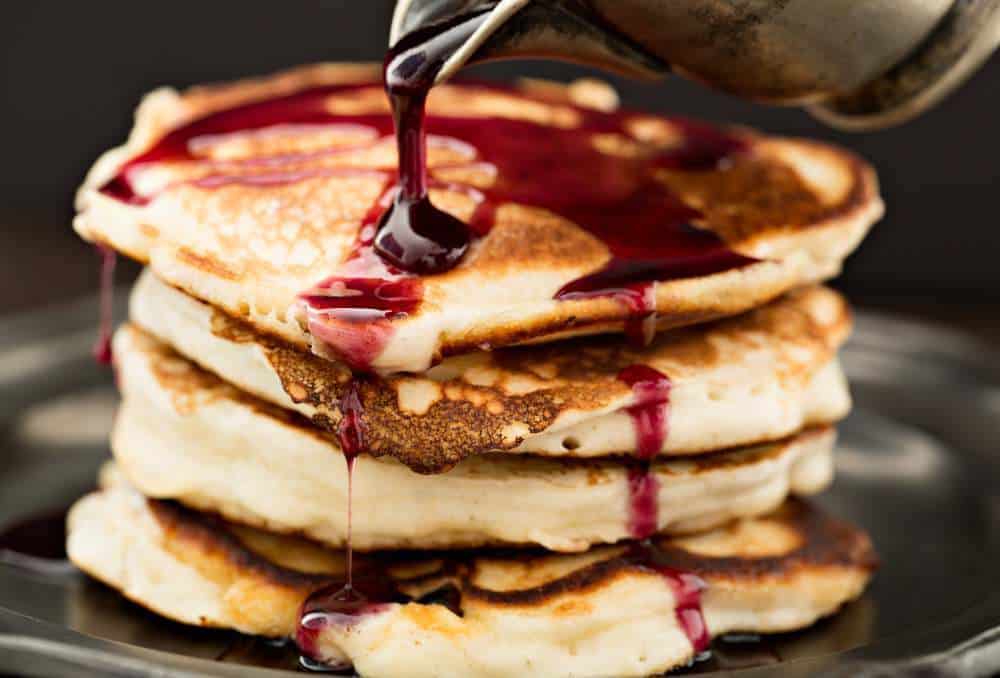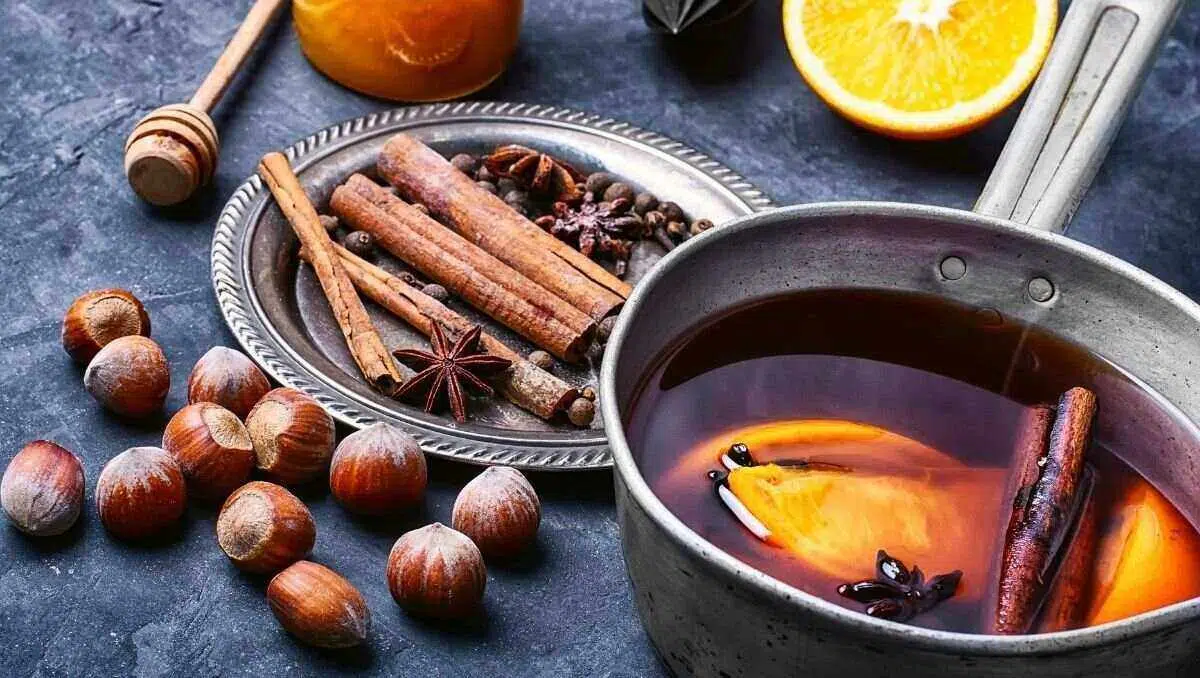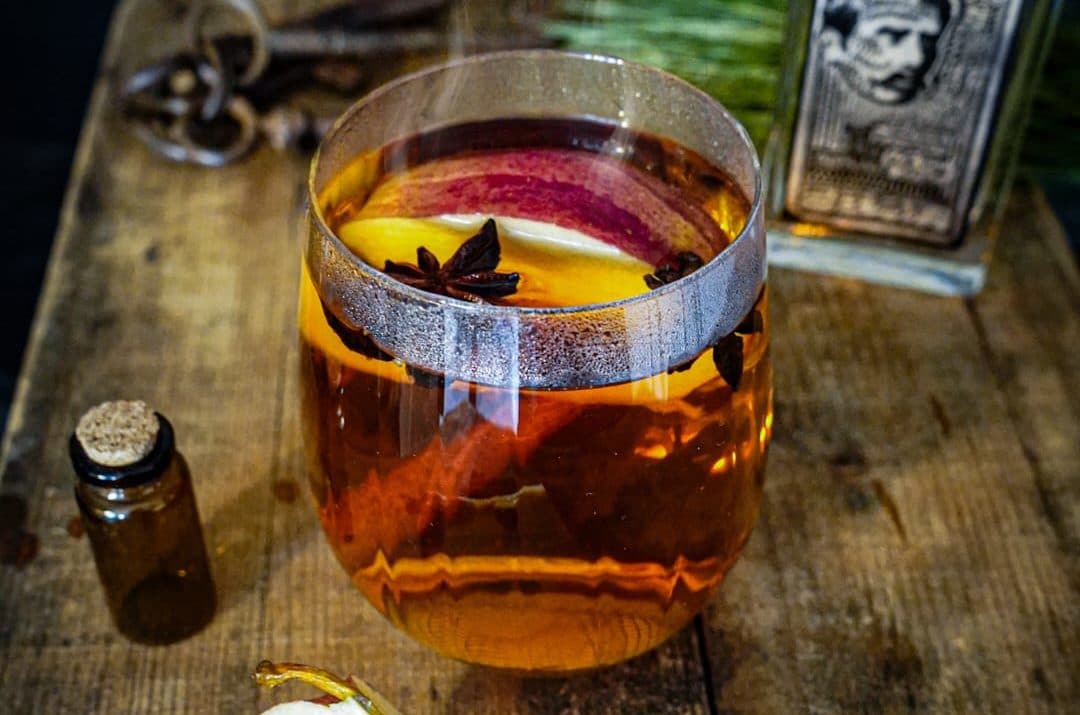Our Christmas spiced Rum Sour is a combination of dark Rum, freshly squeezed lemon juice, homemade syrup, and one egg white.
And if you get the balance of the different ingredients right, I promise once you have tried this recipe, you will want to make it again and again.
We've tasted various Christmas cocktails during the last few years. None were as delicious as this one. It is boozy, full of flavor, sweet, sour, and tastes like Christmas in a glass.
So, if you are looking for a Christmas cocktail for your next Christmas party or family gathering, you found it. Here it is, and it won't disappoint.
Perhaps you already know that Sour Cocktails are among the most popular kinds of mixed drinks. They consist of lemon juice, simple syrup, and a base spirit. - For the classic Rum Sour, that's usually aged Rum. And the same goes for this Christmas version.
Havana Club Añejo Especial is our favorite and awesome value for money. Yet, if you have another favorite brand, that works just as well. -It should be an aged expression, though, and also no spiced Rum. After all, the flavors should not overpower the Christmas syrup.
Mulled wine is delicious and one of the best things about winter. And bringing the Christmasy taste of mulled wine into a Christmas syrup is fun and super easy.
All you need is red wine, sugar, oranges, cinnamon sticks, cloves, star anise, a splash of Rum, and a few drops of Angostura bitters. Just follow the steps in our mulled wine syrup recipe, and you get a great ingredient with minimal effort.
Should you prefer the taste of Glögg, the Scandinavian version of mulled wine, you can also consider adding cardamom to the mix.
If you've never tried a cocktail with egg white foam, you might find the idea weird at first. But it's actually a common practice and doesn't change the taste, just the texture.
It is optional, but it really takes the cocktail to the next level. It makes the texture much creamier, which is especially perfect for the Christmas Rum Sour.
Vegans can use aquafaba instead of egg white. It is also neutral in taste and works equally well.
This Christmas Rum Sour relies on our homemade mulled wine syrup and on the warm flavors of dark Rum. Also, the lemon juice should be freshly squeezed and not a bottled version to make this cocktail perfect.
For more festive drinks, check out this overview of our favorite Christmas Cocktails.

Just like seeing candy cane decorations, smelling and tasting Christmas spices immediately wakes these cozy, warm, and homely feelings. And with our holiday simple syrup, you can incorporate that feeling into cocktails like a Christmas Old Fashioned, Christmas Punch, and more festive cocktail recipes.
Our Christmas simple syrup is a deep red, spiced, sweet, and boozy syrup that is so delicious. Technically, it is a mulled wine syrup with an extra amount of flavor and booze.

Thinking of Christmas Eve, fragrant flavors of mulled wine, orange, cloves, star anise, and gingerbread come to mind. As the latter doesn't fit the rest of the ingredients, I prefer to make a separate gingerbread syrup.
The base of our syrup is a homemade mulled wine. Hence, For our spiced Christmas syrup, we choose the following ingredients:
On top, we need 1 cup of water, a few ounces of aged rum, and a few dashes of Angostura bitters to marry the flavors and add extra depth and complexity.

The best thing about our spiced Christmas simple syrup for cocktails is that it's so versatile. It pairs extremely well with dark, aged spirits like whiskey, rum, or Cognac but is also great with a vodka or tequila base.
It works in hot cocktails, cold drinks, and also as a festive addition to a glass of sparkling wine. Almost any cocktail recipe that incorporates simple syrup is a potential fit.
Here are some recommended drinks to make with our homemade Christmas syrup:

Our homemade Holiday syrup isn't only a great addition to your cocktail shaker, but you can also use it to bring festive flavors to desserts and breakfast.
Making this spiced Christmas syrup requires balancing a lot of flavors. It's much more complex than making cinnamon simple syrup or herbal sweeteners like rosemary syrup. For that reason, we provide some pro tips and tricks to master the recipe.

Sotol could be the new rising star in the sky when it comes to spirits from Mexico. The liquor started gaining traction recently, yet Sotol is still far from mainstream.
As producers of tequila and mezcal struggle with agave shortage, the rise in interest in Sotol doesn't come as a surprise. Learn what makes this non-agave spirit unique, how to drink it, and how it's made.
Sotol is a unique Mexican distillate obtained from the shrub Dasylirion wheeleri, native to the Chihuahuan Desert and commonly known as a desert spoon. This flowering plant typically grows on limestone and is native to West Texas, the southern parts of New Mexico and Arizona, northern Mexico, and Oaxaca.
That also means that contrary to popular belief, sotol is not made from agave like tequila and mezcal. Instead, it is derived from the essence of the spiny leaves of this succulent plant called desert spoon.
The resulting liquor is a clear to amber-colored spirit widely popular in Chihuahua, Durango, and Coahuila. It is available in three different types of Sotol:
In addition to this, there are also Sotol curados. Curds are sweeter versions of the spirit, almost like a liqueur, and are traditionally drunk after dinner. Those are often flavored with pecan, raisins, or cinnamon and infused with herbs and botanicals.

Sotol is made from a plant called Dasylirion wheeleri, commonly known as Desert Spoon, Sotol, or Common Sotol. It is a distinctive member of the Lily Family (Liliaceae). This perennial shrub boasts a captivating rosette of long, spiny leaves, often likened to an evergreen plant and is native to regions spanning from western Texas to southern Arizona.
Its slender, tough leaves are utilized for crafting mats, baskets, and thatching but also play a major role in Sotol production. The plant's flowering characteristics are equally remarkable, with numerous tiny greenish-white flowers arranged in a long, narrow cluster that emerges from the dense leaf cluster.
The smaller Smooth-leaved Sotol (D. leiophyllum) is a close relative, recognizable by its teeth curving towards the leaf base. This resilient shrub, thriving in rocky desert slopes, holds immense value both in cultural practices and as a striking desert ornament.
The process of making sotol mirrors the traditional processes employed in mezcal production. A sotol distillery, known as a vinata, the sotolero (sotol distiller) begins by excavating a pit in the ground. In this pit, the sotol plant is roasted in a conical oven, using locally sourced firewood such as oak or mesquite, which imparts a unique regional flavor.
The whole roasting process lasts three to four days and softens the plant material, which is then milled into a pulp and pressed to extract the sugary, sweet sap. Following this, the sap undergoes a fermentation process in rectangular wooden vats, typically around 4 to 5 days in desert areas and 5 to 7 days in cooler forest regions.
Similar to mezcal, this ancient process retains a rustic charm, as the maestro sotolero relies on taste and sound cues to gauge the fermentation's completion. Referred to as vino at this point, the liquid is then distilled using copper or steel pot stills.
The sotolero employs a unique method to determine the desired alcohol concentration, usually around 50% (100 proof). By pouring the liquid into a cow horn and transferring it back and forth between two horns, the appearance, and movement of "pearls" or bubbles are observed, indicating the alcohol level. Needless to say, this technique requires decades to master.
While many sotols are unaged, referred to as Plata, Joven, or young, some undergo barrel aging. Hacienda de Chihuahua, for instance, offers aged variations like reposado and añejo, akin to specifying the age of Tequila. This intricate and traditional process results in a diverse range of sotols, each reflecting the distinct terroir of the region.
You can break down the process of making Sotol into these six steps:
In short, the taste of sotol can be remarkably complex. Its unique combination of bright and grassy aroma, pine-like flavor, and potential for earthy or vegetal undertones creates a distinctive tasting experience that sets it apart from other agave-based spirits.
Compared to crisp tequila or often-smoky mezcal, sotol tends to be bright and grassy. Depending on how and where the spirit is made some bottlings can have musky, earthy, or vegetal characteristics. It’s not unusual for some to liken Sotol’s funky aroma to sweaty socks.
Sotol's flavor is often characterized by a crisp and clean profile with a distinct pine-like quality. This is complemented by a sappy brightness that shines through the liquor. Some variations exhibit a pronounced minerality, while others feature hints of lemongrass or even a green note reminiscent of the heat found in fresh jalapeño peppers. That all depends on where the specific plants are growing and where the spirit is produced.
Sotol plants that grow in forests have a different flavor profile than desert-grown plants. So the outcome highly depends on where the raw product is harvested. Plants from forests tend to have distinct notes of mint and eucalyptus, whereas its desert-grown brothers have more leathery and earthy notes.

Sotol is traditionally enjoyed neat in Mexico, sipped from a small glass or copita. Some Mexicans also prefer beer on the side to refresh the palate. In addition to sipping it straight, you can enjoy sotol in various infusions known as curados. These sweet infusions are flavored with locally sourced ingredients, such as the popular pecan-cinnamon-raisin curado.
In the U.S., sotol is gradually gaining recognition, often paired with tequila in cocktails, similar to the way bartenders introduced mezcal to the masses. As sotol becomes more accessible and familiar to consumers, it's poised to shine in the cocktail scene.
The Mexican spirit also pairs well with lime juice, making it an excellent substitute for tequila in a Margarita or Paloma cocktail.
Besides Mexican-made sotol bottlings available in the U.S., such as Hacienda de Chihuahua, Sotol Por Siempre, and the upcoming Sotol Clande, Texan producers have also embraced the spirit. But how can a Mexican spirit be produced in the United States?
Due to intricate legal intricacies, American companies are permitted to craft sotol. For instance, Desert Door Distillery, established in 2017 in Driftwood, Texas, just outside of Austin, proudly asserts itself as the pioneer in producing sotol from domestically grown plants. These plants are carefully wild-harvested from ranches in West Texas.
Other Texan sotol producers besides Desert Door Sotol that have emerged in recent years include Genius Liquids and Marfa Spirit Co. The latter has garnered recognition for its collaborative efforts with Mexican growers and respect for their authentic claim to the spirit.
The possibility of sotol production in the United States arises from a unique set of circumstances. In 2002, the Mexican government established a denomination of origin for sotol, reserving the term exclusively for the spirit produced within specific Mexican states.
That is comparable to other regulations like governing champagne's origin in France, this safeguard ensures that sotol reflects the distinct attributes of certain Mexican regions.
Notably, a similar denomination of origin was negotiated during the North American Free Trade Agreement (NAFTA) era in 1994, protecting Mexico's exclusive rights to tequila and mezcal production in the U.S. and Canada.
However, with the replacement of NAFTA by the United States-Mexico-Canada Agreement (USMCA) in 2020, sotol's designation was initially proposed but eventually omitted from the final agreement. This loophole leaves tequila and mezcal as the sole spirits with Mexico's exclusive production rights.
The main difference between sotol and tequila or mezcal is that it's crafted from the sotol plant, while tequila and mezcal originate from various agave species. Tequila is exclusively produced from the blue Weber agave species, Agave tequilana, within specific Mexican regions. Mezcal, on the other hand, can be derived from over 30 agave varieties.
Sotol's advantage lies in its wild harvesting, while agave plants for tequila and mezcal require uprooting, leading to replanting. Tequila's agave hearts are steam-baked, while mezcal and traditional sotol share a similar roasting process using earthen ovens.
The roots of the spirit are in Chihuahua. But the plant is growing between Texas, Arizona, and New Mexico in the US, down to Oaxaca in southern Mexico.
Sotol plants stay intact after harvesting, whereas agave plants are dug out and replanted afterward. So Sotol is more sustainable in that regard.
The sotol plants need about 12-15 years to reach maturity (compared to 6-8 years for blue Weber agave). And as they are growing in the wild, they are vulnerable to being eaten by rodents.
Sotol's production is often considered ecologically less disruptive compared to agave's resource-intensive farming practices. While climate change poses sustainability challenges to both plants, mass sotol production also has effects on the local marine ecosystem.
Regarding flavor, tequila offers a citrusy profile, while mezcal is known for its smokiness. Sotol is often described as smoother and more approachable than its agave-based counterparts being closer to tequila than to mezcal. To fully appreciate these nuanced flavor distinctions, experiencing sotol firsthand through neat tasting is recommended to detect the delicate flavors of the terroir.
Finally, if you like to try Sotol and learn more about individual brands and their production, check out these articles:
Snow falling from the sky, cozy fireplaces, and hot drinks. Each year, the festive season offers a lot to look forward to. But if you want to enjoy a boozy hot cocktail, there is not exactly a large number of attractive choices. To add some variety to your hit list of winter drinks, I have a recipe that will get you warmed up. A delicious, steaming hot Gin cocktail.
But this delicious Gin recipe won't only warm you up on cold winter days. It is so much fun that it hopefully also lifts your mood during the dark season. The name of this drink is “Heißer Kirmes Apfel” which literally translates from German to “hot funfair apple”. It brings together the earthy, sweet aroma of woodruff with citrus and apple in a hot, warming cocktail.
Not everybody is a fan of mulled wine which is why Glühgin is trending for the past couple of years. For all non-Germans: this is a kind of mulled wine but based on Gin instead. It is gaining popularity and inspires many new cocktail recipes based on warmed-up Gin. The recipe I have for you is not exactly a Glühgin, but it picks up the trend.
The base of the cocktail is Elixier Gin. This Gin has a very distinct and pretty strong woodruff taste. And that makes this drink so unique. The mix of woodruff and apple is a real treat. If you aren't familiar with Elixier Gin, you can find some more information in my Elixier Gin article.

On a side note: In Germany, hot alcoholic drinks like this one are very traditional during winter. You can also find delicious mulled wine or Glögg made of exquisite red or white wine at every Christmas Market.
And if you are into the taste of mulled wine, I also have a special Christmas rum cocktail recipe for you. It contains my Christmas syrup which technically bases on mulled wine.